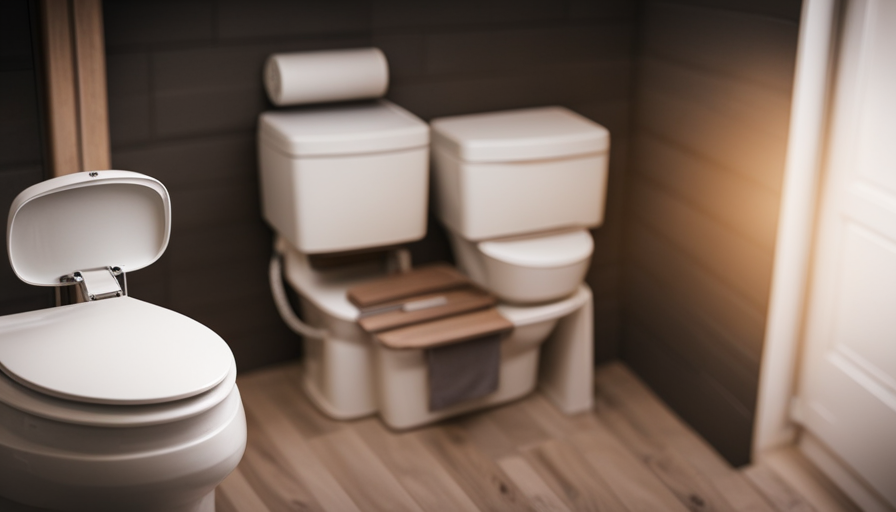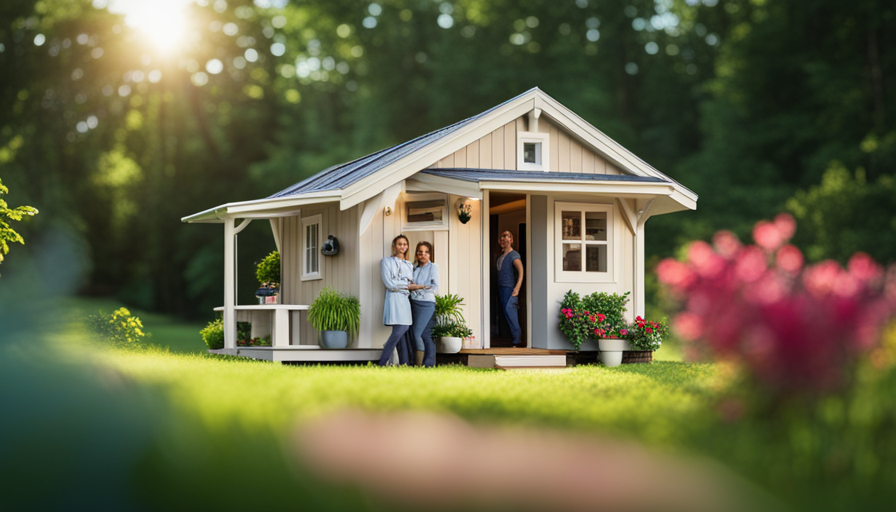As I explore the fascinating realm of tiny houses, I am amazed by the wealth of knowledge that awaits me. These compact homes are becoming a popular choice for those seeking a simpler, environmentally friendly lifestyle. Yet, a burning question remains: what is the average weight of a tiny house?
To unravel this mystery, we must first understand the definition of a tiny house. These pint-sized dwellings typically span less than 400 square feet and are designed to maximize space efficiency. However, their weight can vary greatly depending on several factors.
From the materials used in construction to the appliances and furnishings within, every component contributes to the overall weight of a tiny house. Additionally, the weight distribution plays a crucial role in ensuring stability and safety.
In this article, we will delve into the factors that determine the weight of a tiny house, explore the typical weight range, and discuss strategies for reducing weight. We will also touch upon considerations for off-grid tiny houses and the safety and legal requirements for heavier structures.
Join me as we embark on a journey to find the perfect balance between weight and comfort in a tiny house.
Key Takeaways
- Tiny houses typically range between 100 and 400 square feet in size.
- The weight of a tiny house can vary depending on factors such as construction materials, size, and customization.
- Proper weight distribution is crucial for structural integrity and safety of a tiny house.
- Strategies for reducing weight in a tiny house include using lightweight materials, minimizing interior walls, and utilizing open floor plans.
Understanding the Definition of a Tiny House
So, how heavy is the average tiny house, you may ask? To understand the weight of a tiny house, we must first grasp the definition of what a tiny house is.
A tiny house is a compact, fully-functional dwelling that typically ranges between 100 and 400 square feet in size. These homes are designed to maximize space efficiency and promote minimalistic living. The benefits of living in a tiny house are numerous. They offer affordability, reduced environmental impact, and the freedom to live a simpler, more intentional lifestyle.
Now, let’s delve into the factors that determine the weight of a tiny house. The weight of a tiny house can vary depending on several factors such as the materials used in construction, the size of the house, and the level of customization. Generally, a tiny house can weigh anywhere from 5,000 to 10,000 pounds. However, it is essential to consider the weight distribution within the structure to ensure stability and safety. Factors such as the location of heavy appliances, furniture, and water tanks can significantly impact the overall weight distribution.
Next, we will explore the various factors that contribute to the weight of a tiny house and their impact on its overall stability and mobility.
Factors that Determine the Weight of a Tiny House
When it comes to the weight of a diminutive dwelling, there are several key factors that contribute to its overall heft. These factors impacting tiny house weight include the materials used for construction, the size of the tiny house, and the amount of furnishings and appliances inside. The type of materials used can greatly affect the weight, as heavier materials like wood or metal will add more pounds compared to lighter alternatives like composite panels. Additionally, the size of the tiny house plays a significant role in determining its weight, as larger dimensions require more materials and therefore increase the overall weight. Lastly, the amount of furnishings and appliances inside the tiny house can also have a considerable impact on its weight. The more items and appliances added, the heavier the tiny house becomes. It is important to note that the weight of a tiny house can affect its mobility. A heavier tiny house may require a stronger towing vehicle and can be more challenging to transport. Taking these factors into account, the subsequent section will delve into the typical weight range for tiny houses.
Typical Weight Range for Tiny Houses
The weight range for these charming dwellings usually falls within a manageable range. When it comes to tiny houses, weight distribution is a critical factor to consider. Here are three key factors that contribute to the weight of a tiny house:
-
Construction materials: The materials used in building a tiny house greatly impact its weight. For instance, houses made of heavier materials like concrete or steel will naturally weigh more than those constructed with lighter materials such as wood or aluminum.
-
Interior amenities: The inclusion of appliances, furniture, and other amenities can significantly increase the weight of a tiny house. While these elements add comfort and functionality, they also contribute to the overall weight of the structure.
-
Structural design: The design and layout of a tiny house can affect its weight limitations. A well-planned structure with proper support systems can handle more weight, while a poorly designed one may have weight limitations that need to be carefully considered during construction.
Considering these factors, the typical weight range for a tiny house ranges from around 10,000 to 20,000 pounds. However, it’s crucial to ensure proper weight distribution to avoid exceeding the house’s limitations.
This brings us to the next section, where we’ll discuss the importance of weight distribution in tiny houses.
The Importance of Weight Distribution
Weight distribution in tiny houses is crucial for maintaining structural integrity and ensuring a safe and balanced living environment. Proper weight distribution is essential to prevent excessive stress on certain areas of the structure, which can lead to damage or even collapse. The weight of a tiny house should be evenly distributed throughout the foundation, walls, and roof to ensure stability. This means that heavier items, such as appliances and furniture, should be strategically placed to distribute the weight evenly.
Additionally, the weight distribution should be considered during the design and construction phases to ensure that the structure can support the intended load. Achieving proper weight distribution requires careful planning and consideration. It is important to calculate the weight of each component and distribute it accordingly. For example, the weight of the walls, roof, and flooring should be evenly distributed to avoid putting excessive stress on any one area. Additionally, the placement of heavier items should be balanced to prevent any one side of the tiny house from being overloaded.
In the next section, we will discuss how to calculate the weight of a tiny house and provide tips on achieving the optimal weight distribution for your specific tiny house design.
How to Calculate the Weight of a Tiny House
When it comes to calculating the weight of a tiny house, there are a few key points to consider.
First, using weight estimation tools can provide a reliable estimate of how much the house will weigh. These tools take into account factors such as the materials used, the design of the house, and any additional features or appliances.
Second, it’s always a good idea to consult with a professional, such as an architect or builder, who can provide expert advice and guidance on calculating the weight of a tiny house. They can offer valuable insights and ensure that the weight estimation is accurate and reliable.
Using Weight Estimation Tools
Calculating the heft of an average tiny house is made easier by utilizing weight estimation tools. These tools provide a convenient way to estimate the weight of various components and materials used in constructing a tiny house. However, it’s important to note that weight estimation accuracy may vary due to certain limitations of these tools.
Here are three important factors to consider when using weight estimation tools:
-
Material Variations: Weight estimation tools may not account for variations in materials used, such as different grades of lumber or variations in wall thickness. These variations can affect the overall weight of the tiny house.
-
Customization and Additions: If you plan to customize or add features to your tiny house, weight estimation tools may not accurately predict the weight of these additions. Additional features like solar panels, appliances, or custom-built furniture can significantly impact the overall weight.
-
Construction Techniques: Different construction techniques can affect the weight of a tiny house. Weight estimation tools may not consider the specific construction methods used, such as the use of lightweight materials or alternative building techniques.
Considering these limitations, it’s important to consult with a professional to ensure the accuracy of weight estimates and to account for any specific requirements or considerations for your tiny house project.
Consulting with a Professional
Consulting with a professional can offer valuable insights and guidance for ensuring the accuracy and success of your tiny house project. When it comes to determining the weight of your tiny house, a professional can provide expert advice and use their experience to make accurate estimations. They have access to specialized tools and knowledge that can help you avoid common mistakes and ensure that your tiny house is safe and structurally sound.
By consulting with a professional, you can benefit from their expertise in weight estimation and receive tailored recommendations for your specific project. Their advice can help you make informed decisions about the materials and design elements of your tiny house, ultimately leading to a successful outcome.
Moving forward, it is important to address the common challenges related to heavy tiny houses.
Common Challenges Related to Heavy Tiny Houses
One of the biggest hurdles with heavy tiny houses is the potential strain they can put on the foundation and support structure. Common challenges related to heavy tiny houses include weight limitations and the need for additional reinforcements.
When a tiny house exceeds the weight capacity specified by the foundation or support structure, it can lead to structural issues such as cracks, sinking, or even collapse. To avoid these problems, it is crucial to carefully assess the weight of the tiny house and ensure that it falls within the specified limits. This involves considering the weight of materials used for construction, including the framing, walls, roof, and flooring. Additionally, factors such as appliances, furniture, and water storage tanks should be taken into account.
By accurately calculating the weight and working within the weight limitations, the risk of strain on the foundation and support structure can be minimized.
In the subsequent section about strategies for reducing the weight of a tiny house, we will explore effective methods to achieve a lighter overall structure.
Strategies for Reducing the Weight of a Tiny House
To achieve a lighter overall structure, homeowners can explore various strategies to shed weight from their compact dwelling.
One strategy is to use lightweight construction materials. For example, instead of traditional wood framing, homeowners can opt for steel or aluminum framing, which are lighter and still provide structural integrity. Additionally, using materials like fiberglass or plastic for the exterior siding can significantly reduce the weight of the tiny house.
Another strategy is to utilize innovative construction techniques. For instance, incorporating advanced framing techniques can minimize the amount of lumber used, thus reducing weight. Furthermore, homeowners can consider using foam insulation instead of traditional insulation materials, as foam is lighter and still provides excellent insulation properties.
Lastly, when designing the layout of the tiny house, it is essential to prioritize weight reduction. This can be achieved by minimizing the number of interior walls and using open floor plans.
In conclusion, by employing these strategies and construction techniques, homeowners can significantly reduce the weight of their tiny house, making it easier to transport and maneuver. This leads to the subsequent section about considerations for off-grid tiny houses, where homeowners need to account for energy sources and sustainability.
Considerations for Off-Grid Tiny Houses
Now that we’ve explored strategies for reducing the weight of a tiny house, let’s shift our focus to considerations for off-grid tiny houses.
When it comes to off-grid living, one of the most crucial aspects to consider is power options. Off-grid tiny houses often rely on renewable energy sources such as solar panels or wind turbines. These alternative power sources can provide the necessary energy to run appliances and lighting systems, allowing you to live comfortably without being connected to the conventional power grid.
Another important consideration for off-grid tiny houses is water and waste management. Since off-grid tiny houses are not connected to municipal water and sewage systems, it’s necessary to find alternative solutions. Rainwater harvesting systems can be installed to collect and store rainwater for various household uses. Composting toilets are also popular in off-grid tiny houses as they provide a sustainable way to manage waste without the need for traditional plumbing systems.
To summarize, when setting up an off-grid tiny house, it’s essential to consider off-grid power options such as solar panels or wind turbines, as well as water and waste management solutions like rainwater harvesting systems and composting toilets. These considerations will enable you to live sustainably and self-sufficiently.
In the next section, we’ll explore the safety and legal requirements for heavy tiny houses, which is crucial for ensuring a smooth and compliant living experience.
Safety and Legal Requirements for Heavy Tiny Houses
When it comes to heavy tiny houses, there are two important factors to consider: weight limitations for roads and bridges, and regulations for transportation.
It is crucial to understand these requirements in order to safely and legally transport a heavy tiny house. Not only do roads and bridges have weight restrictions that must be adhered to, but there are also specific regulations in place regarding the transportation of heavy loads, including obtaining permits and following designated routes.
Weight Limitations for Roads and Bridges
Surpassing weight limitations on roads and bridges can have disastrous consequences, causing potential damage and endangering lives. It’s crucial to adhere to weight restrictions to prevent negative impacts on infrastructure.
Here are three key points to consider:
-
Structural Integrity: Roads and bridges are designed to withstand specific weight loads. Exceeding these limits can lead to structural damage, such as cracks, collapses, or even complete failure.
-
Traffic Congestion: Overweight vehicles can contribute to traffic congestion, as they often move at slower speeds and may require special permits or escorts. This can disrupt the flow of traffic and increase travel times for other drivers.
-
Maintenance Costs: Heavy loads put additional stress on roads and bridges, leading to increased wear and tear. This results in higher maintenance and repair costs for authorities, which can impact budgets and delay necessary infrastructure upgrades.
Understanding the weight limitations for roads and bridges is essential for safe and efficient transportation.
Moving on to the next section, let’s explore the regulations for transportation to ensure compliance.
Regulations for Transportation
To ensure compliance, you must follow the regulations for transportation, which include adhering to weight restrictions, obtaining necessary permits, and maintaining proper vehicle documentation. These regulations are put in place to ensure the safety of both the tiny house and other vehicles on the road. Weight limitations for roads and bridges are crucial factors to consider when transporting a tiny house. Exceeding these limitations can lead to structural damage to the roads and bridges, potentially causing accidents and costly repairs. To help visualize these limitations, refer to the table below:
| Road/Bridge | Weight Limit |
|---|---|
| Road A | 10,000 lbs |
| Bridge B | 15,000 lbs |
| Road C | 8,000 lbs |
| Bridge D | 12,000 lbs |
| Road E | 9,000 lbs |
By following the regulations and weight limitations for roads and bridges, you can ensure a safe and smooth transportation process for your tiny house. This brings us to the conclusion: finding the perfect balance between weight and comfort in a tiny house.
Conclusion: Finding the Perfect Balance between Weight and Comfort in a Tiny House
In order to achieve the perfect balance between weight and comfort in your tiny house, you’ll need to carefully consider the average weight of such a structure. Finding the right balance between comfort and weight reduction is crucial in ensuring that your tiny house is both livable and easily transportable. Here are five key factors to consider:
-
Structural Materials: Choosing lightweight materials such as steel or aluminum for the frame and walls can significantly reduce the overall weight of your tiny house while still maintaining structural integrity.
-
Insulation: Opting for efficient insulation materials, like spray foam or rigid foam boards, can provide comfort without adding excessive weight.
-
Furniture and Appliances: Selecting lightweight and compact furniture and appliances is essential to avoid unnecessary weight. Look for items specifically designed for small spaces.
-
Storage Solutions: Utilize innovative storage solutions, such as built-in cabinets and hidden compartments, to maximize space and minimize clutter.
-
Water and Power Systems: Consider lightweight options for your water and power systems, such as portable solar panels and compact water tanks, to reduce the overall weight of your tiny house.
By carefully considering these factors, you can strike the perfect balance between weight and comfort in your tiny house, creating a space that’s both practical and enjoyable to live in.
Frequently Asked Questions
Are there any specific regulations or legal requirements for the weight of a tiny house?
Regulatory requirements and building codes for tiny houses do not specifically address weight limits. However, it’s crucial to ensure that a tiny house is structurally sound and meets safety standards.
Just like any other home, a tiny house should be built to withstand its own weight and potential external forces. Compliance with building codes is necessary to ensure proper construction techniques, materials, and stability. Adhering to these regulations guarantees a safe and durable tiny house.
What are some common challenges that owners of heavy tiny houses face?
Common challenges for owners of heavy tiny houses include issues with weight distribution. When a tiny house is too heavy, it can put excessive strain on the foundation and structural components, leading to potential damage or even collapse. It can also make towing or moving the tiny house more difficult and increase the risk of accidents.
Additionally, heavy tiny houses may require special permits or modifications to meet road weight restrictions, adding to the owner’s logistical and financial challenges.
Can weight distribution affect the safety and stability of a tiny house?
Weight distribution is a critical factor in ensuring the safety and stability of a tiny house. It directly affects the structural integrity, as poorly distributed weight can lead to structural failures and compromised stability.
Additionally, weight distribution impacts the mobility and transportation of a tiny house. An imbalance in weight can make towing or moving the house more challenging and potentially dangerous.
Therefore, careful consideration of weight distribution is crucial for maintaining the safety and stability of a tiny house during transportation.
Are there any strategies or tips for reducing the weight of a tiny house?
Reducing weight in a tiny house can be achieved through various construction techniques. By utilizing lightweight materials like aluminum or fiberglass, the overall weight can be significantly decreased. Incorporating space-saving designs and efficient insulation systems can further contribute to weight reduction.
Additionally, optimizing the layout and eliminating unnecessary features can help minimize the overall weight. These strategies ensure a lighter tiny house without compromising safety or stability.
How do off-grid tiny houses differ in terms of weight considerations compared to traditional tiny houses?
Weight considerations for off-grid tiny houses differ from traditional tiny houses in several ways. Off-grid tiny houses need to be lightweight to minimize energy usage and maximize portability. This means using lightweight materials such as aluminum or composite panels for the walls and roof.
Additionally, off-grid tiny houses often require additional weight considerations for renewable energy systems, such as solar panels or wind turbines. These factors make off-grid tiny houses lighter than traditional ones.
Conclusion
In conclusion, finding the perfect balance between weight and comfort in a tiny house is crucial. By understanding the factors that determine the weight of a tiny house and employing strategies to reduce it, one can create a safe and efficient living space.
Just like a well-balanced tightrope walker, the weight distribution in a tiny house is vital for stability and functionality. Therefore, calculating the weight accurately and adhering to safety and legal requirements is essential for a successful tiny house experience.
Hi, I’m Emma. I’m the Editor in Chief of Tiny House 43, a blog all about tiny houses. While tree houses are often associated with childhood, they can be the perfect adult retreat. They offer a cozy space to relax and unwind, surrounded by nature. And since they’re typically built on stilts or raised platforms, they offer stunning views that traditional homes simply can’t match. If you’re looking for a unique and romantic getaway, a tree house tiny house might just be the perfect option.










